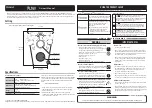
4-3
4.2.3 Intake.
The brass intake nozzle is located on the front, left end of the instrument, and is designed to fit 0.25-
inch tubing. Under most applications, the vinyl tubing connected here connects to the particulate filter mounted on
the front of the instrument and conducts the air inside the instrument.
4.2.4 Mass Airflow Sensor.
The flow of air into the instrument is measured by a mass airflow sensor connected
internally to the intake nozzle. The mass airflow sensor produces an analog voltage that the main board measures
and converts to an airflow in L/min (liters of air per minute). The mass airflow sensor is connected to the in-line/off-
line desiccant switch.
4.2.5 In-line/Off-line Airflow Desiccant Switch.
The in-line/off-line airflow desiccant switch is located on the
back end of the instrument, and is connected to the incoming air through the mass airflow sensor. The function of
the in-line/off-line airflow desiccant switch is to divert the incoming air through the instrument’s desiccant chamber
when in the in-line (down) position. When off-line (or up) position, the incoming air bypasses the desiccant chamber
and enters the chamber directly.
4.2.6 Airflow Desiccant.
The airflow desiccant chamber is mounted on the back of the instrument, and serves to
dry the incoming air whenever the desiccant switch is in the in-line position. The desiccant used is a color-indicating
silica gel that is blue when the desiccant is able to absorb moisture, and pink when it is saturated with moisture. The
color of the desiccant may be seen through the window on the back end of the instrument. See Section 6.3 on
replacement of the desiccant. Dry air exits this chamber and enters the tritium chamber.
4.2.7 Tritium Detector Ion Chamber.
Incoming air from the desiccant chamber or from the mass airflow
sensor (depending on the position of the in-line/off-line desiccant switch) enters the tritium ionization chamber. The
polarization voltage applied to the tritium chamber causes a low-level current to flow when ionization occurs in the
ion chamber detector. The magnitude of this current is directly proportional to the level of tritium present in the air
being monitored. The mark on the instrument can closest to the back of the instrument identifies the center of the
tritium chamber. Note that ionization of the air being monitored can also be produced by either a radioactive
contaminant in the air or by the action of a background gamma radiation incident to the tritium detector. Since it is
the purpose of this unit to measure the concentration of tritium in the air, the contribution made by gamma
background must be subtracted. This subtraction is accomplished by means of the gamma compensation ion
chamber detector.
4.2.8 Gamma Compensation Ion Chamber Detector.
The gamma compensation ion chamber detector is
equal in size and shape to the tritium detector but is isolated from the air being monitored. It will only react to
gamma radiation. The mark on the instrument can closest to the front of the instrument identifies the center of the
gamma chamber. The current produced by this detector is electrically subtracted from the tritium chamber’s current
by the electrometer board, which provides an output voltage proportional to the tritium level only.
4.2.9 Electrometer Board and Temperature Sensor
.
The electrometer board is mounted to the gamma and
tritium chambers and is connected to the electrodes of both chambers. The signal produced by the detector is an
extremely low DC current in the order of femtoamperes that is applied to the electrometer, which converts the low-
level DC current into a DC voltage to send to the amplifier on the main board. The electrometer board also has a
temperature sensor that produces an analog voltage. This analog voltage is measured by the microprocessor on the
main board. The electrometer board has a gasketed lid with a window to view the desiccant. To work effectively,
the electrometer board must be kept clean and dry.
4.2.10 Pump.
The pump draws incoming air through the instrument and through the tritium ion chamber detector.
The air passes through the pump and is then exhausted from the equipment by the OUT nozzle back into the area
being monitored or to a designated location. The pump used to draw air into the tritium chamber is a relay-driven
positive displacement pump. It is powered by the pump drive circuit, consisting of a transistor switch and switching
power supply.
Содержание 3100
Страница 1: ...LUDLUM MODEL 3100 TRITIUM IN AIR MONITOR July 2019 ...
Страница 2: ...LUDLUM MODEL 3100 TRITIUM IN AIR MONITOR July 2019 ...
Страница 11: ...1 2 Figure 1 2 Front View Model 3100 ...
Страница 31: ......
Страница 34: ......
Страница 35: ...5 3 Figure 5 5 Rotary Draw Latches Detail View BF Figure 5 6 Rack Mount Safety Strap ...
Страница 36: ......
















































